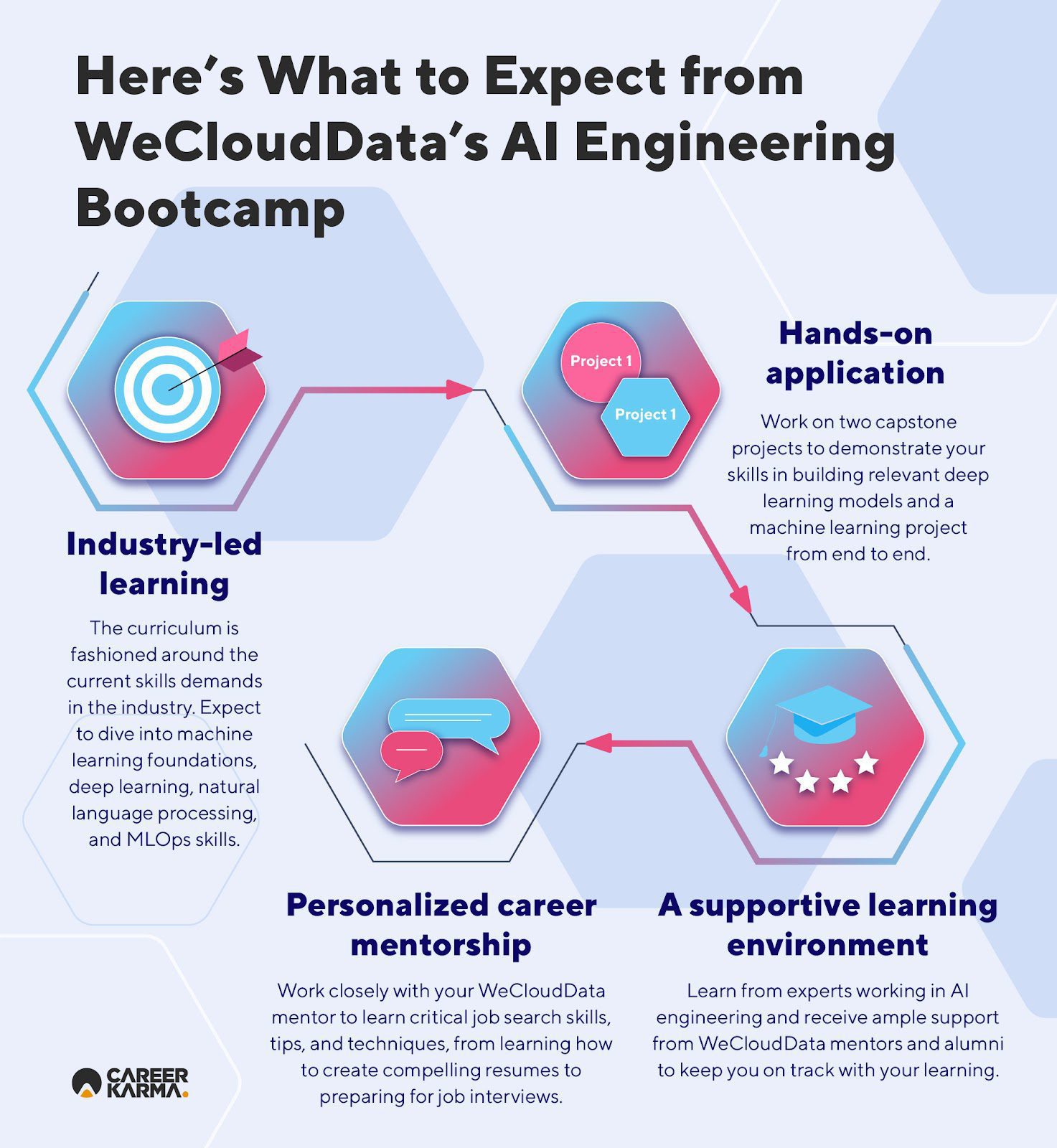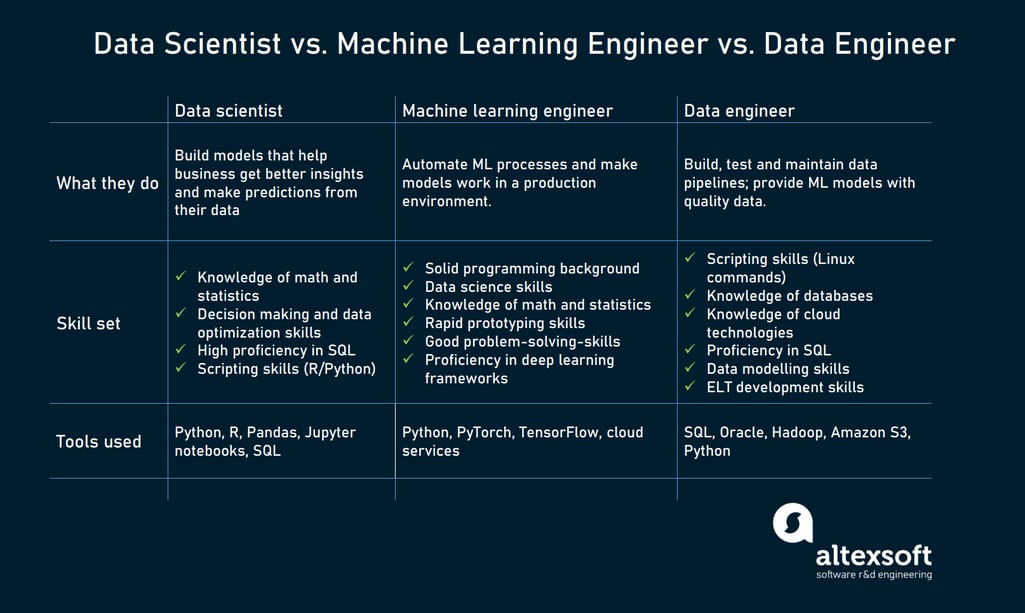All Categories
Featured
Table of Contents
- – The 6-Second Trick For What Is The Best Route ...
- – The Best Strategy To Use For Leverage Machine ...
- – How To Become A Machine Learning Engineer - E...
- – Little Known Questions About Certificate In M...
- – 10 Easy Facts About Advanced Machine Learnin...
- – All about 🔥 Machine Learning Engineer Cours...
- – Indicators on How To Become A Machine Learni...
Some individuals believe that that's disloyalty. If someone else did it, I'm going to use what that person did. I'm compeling myself to think via the possible remedies.
Dig a little bit deeper in the mathematics at the beginning, simply so I can develop that structure. Santiago: Finally, lesson number seven. I do not believe that you have to understand the nuts and bolts of every formula prior to you use it.
I've been using semantic networks for the lengthiest time. I do have a sense of how the gradient descent works. I can not clarify it to you right now. I would certainly need to go and inspect back to in fact obtain a far better instinct. That does not mean that I can not resolve points making use of semantic networks, right? (29:05) Santiago: Trying to require people to assume "Well, you're not going to be successful unless you can clarify every solitary detail of just how this functions." It goes back to our sorting example I assume that's just bullshit guidance.
As an engineer, I've dealt with lots of, numerous systems and I have actually made use of numerous, many points that I do not comprehend the nuts and screws of how it functions, despite the fact that I understand the influence that they have. That's the final lesson on that string. Alexey: The funny thing is when I believe about all these collections like Scikit-Learn the formulas they use inside to execute, as an example, logistic regression or something else, are not the exact same as the algorithms we research in maker understanding courses.
The 6-Second Trick For What Is The Best Route Of Becoming An Ai Engineer?
Even if we attempted to discover to get all these basics of device discovering, at the end, the formulas that these collections use are various. Santiago: Yeah, definitely. I think we require a whole lot more pragmatism in the industry.

I generally speak to those that desire to work in the market that want to have their influence there. I do not dare to talk about that since I don't know.
Right there outside, in the sector, pragmatism goes a lengthy way for certain. Santiago: There you go, yeah. Alexey: It is a great inspirational speech.
The Best Strategy To Use For Leverage Machine Learning For Software Development - Gap
One of the points I desired to ask you. Initially, let's cover a pair of things. Alexey: Let's start with core tools and frameworks that you require to learn to in fact transition.
I know Java. I know how to make use of Git. Maybe I know Docker.
Santiago: Yeah, absolutely. I assume, number one, you must start discovering a little bit of Python. Because you currently recognize Java, I don't think it's going to be a significant change for you.
Not due to the fact that Python is the same as Java, yet in a week, you're gon na obtain a lot of the distinctions there. You're gon na have the ability to make some progress. That's primary. (33:47) Santiago: After that you get particular core devices that are mosting likely to be used throughout your entire occupation.
How To Become A Machine Learning Engineer - Exponent - Truths
You get SciKit Learn for the collection of equipment understanding algorithms. Those are tools that you're going to have to be using. I do not recommend simply going and finding out about them out of the blue.
Take one of those programs that are going to begin presenting you to some troubles and to some core concepts of device knowing. I do not bear in mind the name, yet if you go to Kaggle, they have tutorials there for cost-free.
What's excellent regarding it is that the only demand for you is to recognize Python. They're going to provide a trouble and tell you how to utilize choice trees to address that specific issue. I believe that process is very effective, because you go from no maker finding out history, to understanding what the problem is and why you can not resolve it with what you recognize right currently, which is straight software program design methods.
Little Known Questions About Certificate In Machine Learning.
On the various other hand, ML designers focus on structure and deploying artificial intelligence models. They concentrate on training versions with data to make predictions or automate jobs. While there is overlap, AI designers take care of more varied AI applications, while ML designers have a narrower concentrate on device understanding formulas and their useful application.

Artificial intelligence engineers concentrate on creating and releasing artificial intelligence versions into manufacturing systems. They work on engineering, making sure designs are scalable, reliable, and incorporated right into applications. On the various other hand, data researchers have a wider role that includes data collection, cleaning, exploration, and building models. They are typically in charge of extracting insights and making data-driven choices.
As companies increasingly adopt AI and artificial intelligence technologies, the need for competent professionals grows. Artificial intelligence engineers work with cutting-edge jobs, contribute to innovation, and have competitive incomes. However, success in this area requires continuous knowing and staying up to date with progressing innovations and strategies. Artificial intelligence functions are generally well-paid, with the potential for high earning possibility.
ML is essentially different from typical software advancement as it concentrates on training computers to discover from data, as opposed to shows specific policies that are carried out methodically. Unpredictability of end results: You are possibly used to composing code with predictable results, whether your feature runs as soon as or a thousand times. In ML, nonetheless, the results are less certain.

Pre-training and fine-tuning: How these designs are trained on large datasets and after that fine-tuned for specific jobs. Applications of LLMs: Such as message generation, sentiment analysis and info search and retrieval.
10 Easy Facts About Advanced Machine Learning Course Described
The ability to manage codebases, combine changes, and resolve problems is just as crucial in ML advancement as it is in standard software jobs. The abilities developed in debugging and testing software application applications are highly transferable. While the context may alter from debugging application logic to determining concerns in data handling or design training the underlying principles of methodical investigation, hypothesis screening, and repetitive refinement are the same.
Machine knowing, at its core, is heavily reliant on statistics and probability concept. These are crucial for recognizing exactly how algorithms find out from data, make predictions, and review their performance. You must consider becoming comfy with principles like statistical importance, distributions, theory screening, and Bayesian thinking in order to style and analyze models efficiently.
For those curious about LLMs, a thorough understanding of deep understanding designs is helpful. This consists of not just the technicians of neural networks but also the architecture of details versions for various use cases, like CNNs (Convolutional Neural Networks) for picture handling and RNNs (Persistent Neural Networks) and transformers for consecutive data and all-natural language processing.
You need to recognize these concerns and discover strategies for recognizing, alleviating, and interacting regarding predisposition in ML designs. This consists of the potential influence of automated decisions and the moral implications. Lots of versions, especially LLMs, need considerable computational resources that are often supplied by cloud platforms like AWS, Google Cloud, and Azure.
Structure these abilities will not only assist in a successful shift right into ML yet additionally ensure that developers can add efficiently and properly to the improvement of this vibrant area. Theory is important, however nothing beats hands-on experience. Beginning functioning on projects that allow you to apply what you have actually learned in a useful context.
Participate in competitions: Join systems like Kaggle to get involved in NLP competitors. Build your tasks: Begin with easy applications, such as a chatbot or a text summarization device, and gradually increase complexity. The area of ML and LLMs is quickly advancing, with new innovations and technologies emerging frequently. Remaining updated with the newest research and trends is important.
All about 🔥 Machine Learning Engineer Course For 2023 - Learn ...
Contribute to open-source projects or create blog posts about your learning journey and projects. As you gain know-how, start looking for opportunities to incorporate ML and LLMs right into your job, or look for new duties focused on these innovations.

Possible usage instances in interactive software application, such as recommendation systems and automated decision-making. Recognizing unpredictability, fundamental statistical steps, and probability distributions. Vectors, matrices, and their role in ML formulas. Mistake reduction strategies and gradient descent explained simply. Terms like model, dataset, features, labels, training, reasoning, and validation. Data collection, preprocessing methods, model training, analysis procedures, and deployment factors to consider.
Choice Trees and Random Woodlands: Intuitive and interpretable versions. Matching trouble kinds with proper models. Feedforward Networks, Convolutional Neural Networks (CNNs), Persistent Neural Networks (RNNs).
Information circulation, makeover, and attribute design approaches. Scalability principles and performance optimization. API-driven strategies and microservices assimilation. Latency administration, scalability, and version control. Continuous Integration/Continuous Deployment (CI/CD) for ML operations. Design monitoring, versioning, and efficiency monitoring. Identifying and attending to modifications in design performance over time. Dealing with performance bottlenecks and resource management.
Indicators on How To Become A Machine Learning Engineer (2025 Guide) You Should Know

Training course OverviewMachine learning is the future for the future generation of software professionals. This course acts as a guide to equipment discovering for software program designers. You'll be presented to three of one of the most relevant parts of the AI/ML self-control; overseen understanding, neural networks, and deep discovering. You'll realize the distinctions between typical programming and artificial intelligence by hands-on growth in monitored discovering prior to building out complicated distributed applications with semantic networks.
This program offers as a guide to device lear ... Show More.
Table of Contents
- – The 6-Second Trick For What Is The Best Route ...
- – The Best Strategy To Use For Leverage Machine ...
- – How To Become A Machine Learning Engineer - E...
- – Little Known Questions About Certificate In M...
- – 10 Easy Facts About Advanced Machine Learnin...
- – All about 🔥 Machine Learning Engineer Cours...
- – Indicators on How To Become A Machine Learni...
Latest Posts
Cracking The Mid-level Software Engineer Interview – Part I (Concepts & Frameworks)
Top Software Engineering Interview Questions And How To Answer Them
The Ultimate Guide To Preparing For An Ios Engineering Interview
More
Latest Posts
Cracking The Mid-level Software Engineer Interview – Part I (Concepts & Frameworks)
Top Software Engineering Interview Questions And How To Answer Them
The Ultimate Guide To Preparing For An Ios Engineering Interview